
Kuyavian–Pomeranian Voivodeship is one of Poland's 16 voivodeships (provinces).

Magdeburg rights were a set of town privileges first developed by Otto I, Holy Roman Emperor (936–973) and based on the Flemish Law, which regulated the degree of internal autonomy within cities and villages granted by the local ruler. Named after the German city of Magdeburg, these town charters were perhaps the most important set of medieval laws in Central Europe. They became the basis for the German town laws developed during many centuries in the Holy Roman Empire. The Magdeburg rights were adopted and adapted by numerous monarchs, including the rulers of Bohemia, Hungary, Poland and Lithuania, a milestone in the urbanization of the region which prompted the development of thousands of villages and cities.

Świętokrzyskie Voivodeship, also known as Holy Cross Voivodeship, is a voivodeship (province) in southeastern Poland, in the historical region of Lesser Poland. The province's capital and largest city is Kielce.

Lower Silesian Voivodeship in southwestern Poland, is one of the 16 voivodeships (provinces) into which Poland is divided. It covers an area of 19,946 square kilometres (7,701 sq mi), and as of 2019 has a total population of 2,899,986.

Subcarpathian Voivodeship is a voivodeship, or province, in the southeastern corner of Poland. Its administrative capital and largest city is Rzeszów. Along with the Marshal, it is governed by the Subcarpathian Regional Assembly.

Port Island is an island located between Gdańsk Bay, Śmiała Wisła and Leniwka in northern Poland within the city limits of Gdańsk.

The Collegiate church of the Blessed Virgin Mary, Queen of the World in Stargard, or simply the St. Mary's Church, is a noted architectural monument in Polish Pomerania. It closes the eastern part of the Old Town Market. The monument is a part of the European Route of Brick Gothic. It is a collegiate church, but inhabitants of the town commonly call it "the Cathedral".

The Abbey church in Czerwińsk nad Wisłą, officially known as the Basilica of the Annunciation of Holy Virgin Mary, is a historic church, built in the 12th century. Despite Gothic and Baroque elements added in later centuries, the basilica remains one of the most valuable examples of Romanesque architecture in Poland, and as such it is listed as a Historic Monument of Poland.

Sulejówek is a town in Poland, about 18 km east of Warsaw city centre and part of its metropolitan area. It is located in Masovian Voivodeship, in Mińsk County. Its population numbers 19323 (2011).
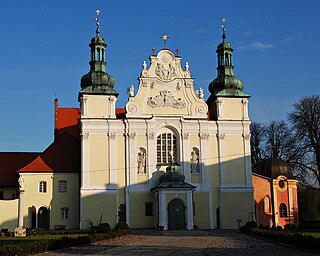
Holy Trinity Church is a Romanesque-Baroque basilica in Strzelno consecrated in 1216. It forms part of the former Norbertine Abbey complex, which is listed as a Historic Monument of Poland.
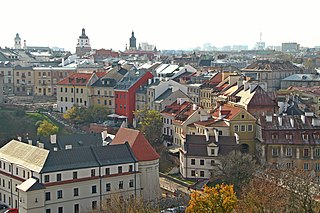
Lublin Old Town is the historic town center of Lublin, Poland, one of the most significant Polish complexes of historic buildings. The Crown Tribunal and the 14th-century Kraków Gate, leading from the Old Town to the city center, are commonly considered symbols of the city.
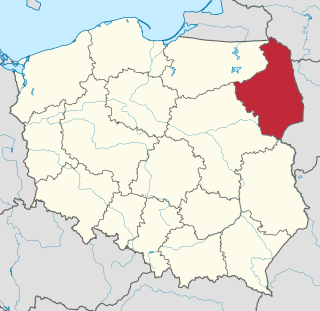
Podlaskie Voivodeship is a voivodeship (province) in northeastern Poland. The name of the province refers to the historical region of Podlachia, and part of its territory corresponds to that region. The capital and largest city is Białystok.

Lubostroń is a village in the administrative district of Gmina Łabiszyn, within Żnin County, Kuyavian-Pomeranian Voivodeship, in north-central Poland. It lies approximately 7 kilometres (4 mi) south of Łabiszyn, 16 km (10 mi) north-east of Żnin, and 26 km (16 mi) south of Bydgoszcz.

Staniątki is a village in the administrative district of Gmina Niepołomice, within Wieliczka County, Lesser Poland Voivodeship, in southern Poland. It lies approximately 3 kilometres (2 mi) south-west of Niepołomice, 11 km (7 mi) east of Wieliczka, and 20 km (12 mi) east of the regional capital Kraków.

Bieliny is a village in Kielce County, Świętokrzyskie Voivodeship, in south-central Poland. It is the seat of the gmina called Gmina Bieliny. It lies approximately 21 km (13 mi) east of the regional capital Kielce. Bieliny is near the highest peaks of the Świętokrzyskie Mountains - Łysica, Agata and Łysa Góra.
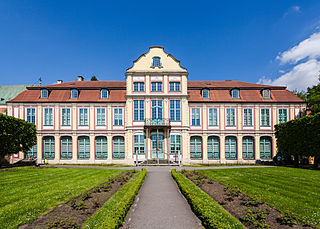
The Abbots' Palace in Oliwa is a rococo palace in Oliwa, a quarter of Gdańsk. It houses the Department of Modern Art of the National Museum in Gdańsk, and along with the Cistercian-Cathedral complex in Oliwa it is listed as a Historic Monument of Poland.

Szczecin agglomeration is the urban agglomeration of the city of Szczecin and surrounding towns in the Polish-German border area.

Basilica on the Holy Mountain in Głogówko, Poland, is a historic Oratorian, Renaissance Minor Basilica. The shrine is modelled on the Venetian Santa Maria della Salute.
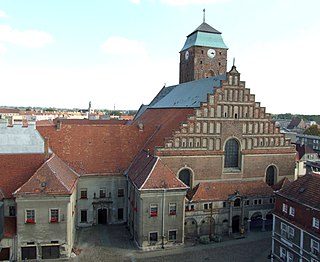
Assumption of the Blessed Virgin Mary Church in Żagań, Poland, is a Gothic church built between the fourteenth and second-half of the fifteenth century. The church is part of the Roman Catholic Diocese of Zielona Góra-Gorzów. It is listed as a Historic Monument of Poland.

St. John the Evangelist's Church in Paczków, Poland, is a Gothic church built in the fourteenth century. The church belongs to the Roman Catholic Diocese of Opole.





























